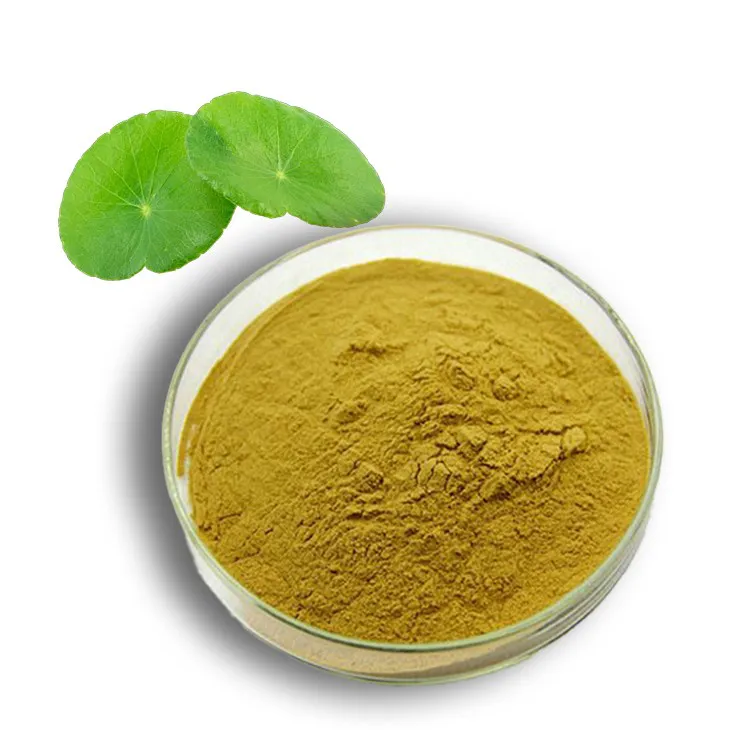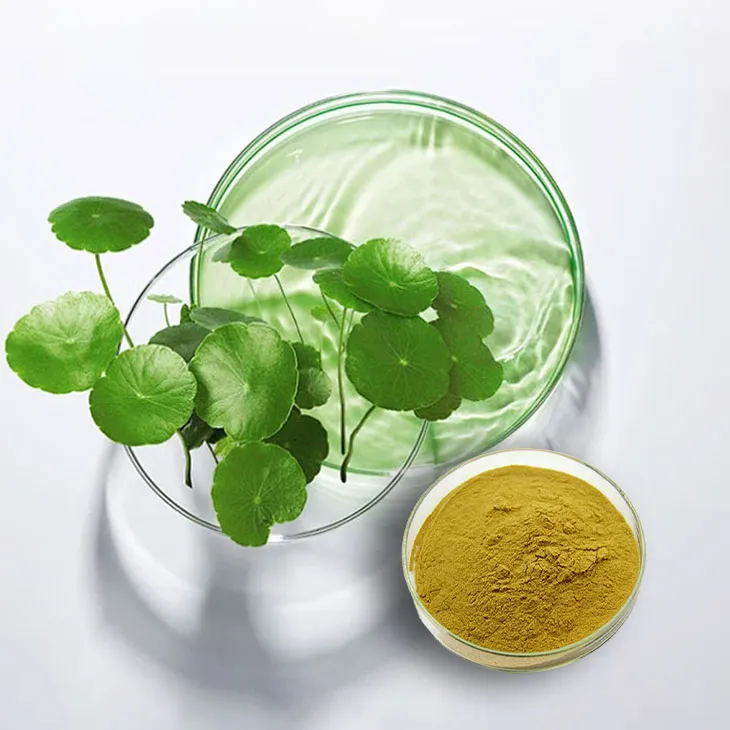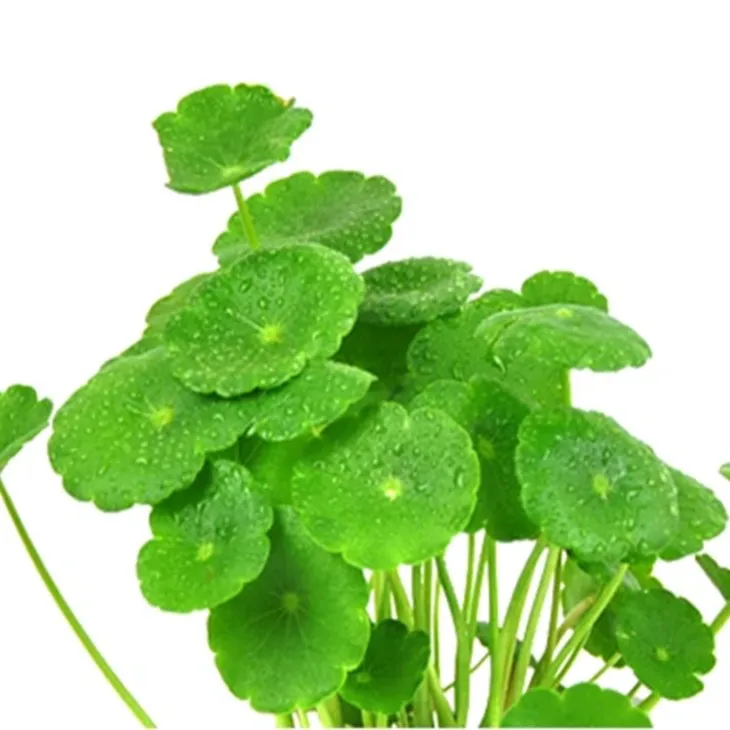- 0086-571-85302990
- sales@greenskybio.com
Centella asiatica extract: Uses, advantages, manufacturing processes.
2024-11-13

1. Introduction
Centella asiatica, also known as gotu kola, is a herbaceous plant native to Asia. Centella Asiatica Extract has been recognized for its numerous beneficial properties. It has a long history of use in traditional medicine systems such as Ayurveda and Traditional Chinese Medicine. In modern times, it has gained significant popularity in both the cosmetic and pharmaceutical industries.

2. Uses
2.1 Cosmetic uses
2.1.1 Skin soothing
- Centella Asiatica Extract is excellent for soothing irritated skin. It contains compounds that can calm down inflammation on the skin surface. This makes it a popular ingredient in products designed for sensitive skin types. For example, in creams and lotions for those with eczema or rosacea, it can help reduce redness and discomfort.
- When the skin is exposed to environmental stressors like pollution or harsh weather conditions, Centella Asiatica Extract can act as a protective and soothing agent. It helps to restore the skin's natural balance and prevent further damage.
- Another significant use in cosmetics is for scar fading. The extract promotes the production of collagen in the skin. Collagen is essential for skin repair and regeneration. By increasing collagen synthesis, it can help to fill in the gaps in damaged skin tissue, gradually reducing the appearance of scars. Whether it is acne scars or surgical scars, products containing Centella asiatica extract may offer some improvement over time.
- It also helps in improving the texture of the skin around the scar area. The skin becomes smoother and more even - toned, which further enhances the overall appearance of the scar - affected area.
- Centella asiatica extract has moisturizing properties as well. It can help to retain moisture in the skin. This is because it strengthens the skin's barrier function. A healthy skin barrier is crucial for preventing water loss from the skin. When used in moisturizers, it can keep the skin hydrated for a longer period compared to some other ingredients.
- It is suitable for different skin types when it comes to moisturizing. For dry skin, it provides essential hydration, and for combination skin, it helps to balance the moisture levels in different areas of the face.
2.2 Pharmaceutical uses
2.2.1 Neurological problems
- In the pharmaceutical field, Centella asiatica extract may play a role in the treatment of neurological problems. Some studies suggest that it has potential neuroprotective effects. It may help to protect nerve cells from damage, which could be beneficial in conditions such as Alzheimer's disease or other neurodegenerative disorders.
- It may also improve cognitive function. For example, it could enhance memory and concentration. Although more research is needed to fully understand its mechanisms and effectiveness in these areas, the initial findings are promising.
- Regarding circulatory problems, the extract may have a positive impact on blood vessels. It can help to strengthen the walls of blood vessels, making them more elastic. This is important for maintaining healthy blood circulation throughout the body.
- It may also have anti - clotting properties. By preventing the formation of blood clots, it can reduce the risk of certain circulatory disorders such as deep - vein thrombosis or stroke. However, it should be noted that any use for these serious medical conditions should be under the supervision of a medical professional.

3. Advantages
3.1 Compatibility with the human body
- One of the major advantages of Centella asiatica extract is its compatibility with the human body. As a plant - derived extract, it is generally well - tolerated by most people. Compared to some synthetic substances used in cosmetics and pharmaceuticals, it has a lower risk of causing allergic reactions or other adverse side effects.
- It has been used in traditional medicine for centuries, which also indicates its relative safety. However, it is still important to note that individual sensitivities may vary, and proper testing should be carried out when introducing a new product containing this extract.
- Centella asiatica contains a variety of beneficial components. These include triterpenoids such as asiaticoside, madecassoside, and asiatic acid. These compounds work together to provide the various beneficial effects of the extract. For example, asiaticoside is known for its role in skin repair and collagen synthesis, while madecassoside has anti - inflammatory properties.
- The presence of multiple active components means that the extract can have a more comprehensive effect on the body or skin. It is not relying on a single ingredient to achieve its functions, which may make it more effective in treating complex conditions or achieving multiple cosmetic goals.

4. Manufacturing processes
4.1 Raw material selection
- The first step in the manufacturing process of Centella asiatica extract is the careful selection of raw materials. High - quality Centella asiatica plants are chosen. These plants are preferably grown in their natural habitats or under controlled cultivation conditions that mimic their native environment. This ensures that the plants contain the optimal levels of active ingredients.
- The plants should be free from contaminants such as pesticides, heavy metals, and other harmful substances. Quality control measures are implemented at this stage to screen the raw materials and reject any sub - standard plants.
- There are several extraction methods used to obtain Centella asiatica extract. One common method is solvent extraction. In this process, solvents such as ethanol or water are used to dissolve the active ingredients from the plant material. Ethanol extraction is often preferred for its ability to extract a wide range of compounds, including the triterpenoids. Water extraction, on the other hand, is more suitable for obtaining water - soluble components and is considered a more "natural" option in some cases.
- Another method is supercritical fluid extraction. This uses supercritical carbon dioxide as the extraction solvent. Supercritical carbon dioxide has properties that allow it to penetrate the plant material effectively and extract the desired components. This method has the advantage of being more environmentally friendly compared to some traditional solvent extraction methods, as carbon dioxide can be easily removed and recycled, leaving no solvent residues in the final extract.
- Regardless of the extraction method used, modern extraction techniques are designed to be precise. They aim to extract the active ingredients while minimizing the extraction of unwanted substances. This helps to maintain the integrity and efficacy of the extract.
- After extraction, the extract usually undergoes purification and concentration processes. Purification is carried out to remove any remaining impurities, such as plant debris, proteins, or other non - active components. This can be achieved through filtration, centrifugation, or other separation techniques.
- Concentration is then done to increase the concentration of the active ingredients in the extract. This is important for ensuring that the final product contains a sufficient amount of the beneficial components. Concentration methods may include evaporation under reduced pressure or other techniques that can remove excess solvents while leaving the active ingredients intact.
- Throughout the manufacturing process, strict quality control is essential. Analytical methods are used to determine the composition and quality of the extract. This includes techniques such as high - performance liquid chromatography (HPLC) to identify and quantify the levels of key active ingredients like asiaticoside and madecassoside.
- Microbial testing is also carried out to ensure that the extract is free from harmful bacteria, fungi, and other microorganisms. Physical properties such as appearance, odor, and solubility are also monitored to ensure that the final product meets the required standards.
5. Conclusion
Centella asiatica extract is a valuable substance with diverse uses in cosmetics and pharmaceuticals. Its advantages, such as its compatibility with the human body and the presence of multiple beneficial components, make it an attractive option in both industries. The manufacturing processes, which involve careful raw material selection, precise extraction, purification, concentration, and strict quality control, ensure the production of high - quality extracts. As research continues, we can expect to see further exploration of its potential applications and a better understanding of its mechanisms of action.
FAQ:
What are the main uses of Centella asiatica extract in cosmetics?
Centella asiatica extract is mainly used in cosmetics to soothe irritated skin, fade scars, and moisturize. It can help calm the skin when it is inflamed or irritated, reduce the appearance of scars by promoting skin regeneration, and keep the skin hydrated.
How can Centella asiatica extract contribute to the treatment of neurological problems?
The specific mechanisms by which Centella asiatica extract contributes to the treatment of neurological problems are still under research. However, it is believed that certain bioactive compounds in the extract may have effects on nerve cells, such as promoting nerve cell repair, reducing inflammation in the nervous system, or modulating neurotransmitter function.
What makes Centella asiatica extract compatible with the human body?
Centella asiatica extract is plant - derived. Since plants are a natural source, the extract is more likely to be recognized and metabolized by the human body compared to synthetic substances. The body has evolved to deal with natural compounds, which generally results in better compatibility.
What are the modern manufacturing techniques for Centella asiatica extract?
Modern manufacturing techniques for Centella asiatica extract may include methods such as supercritical fluid extraction, which can precisely extract the active ingredients while maintaining their integrity. Another common technique is solvent extraction, where appropriate solvents are used to isolate the desired components. Additionally, advanced purification and concentration steps are often involved to ensure the quality and efficacy of the final extract.
Are there any side effects of using Centella asiatica extract?
While Centella asiatica extract is generally considered safe for most people, some individuals may experience allergic reactions. It is also important to note that if used inappropriately, for example, in excessive amounts in cosmetics or medications, it may cause skin irritation or other adverse effects. However, when used within the recommended guidelines, side effects are relatively rare.
Related literature
- Centella asiatica: A Review of Its Ethnopharmacology, Phytochemistry, and Pharmacology"
- "The Therapeutic Potential of Centella asiatica Extract in Skin Health and Wound Healing"
- "Centella asiatica in Neurological Disorders: A Review of Preclinical and Clinical Studies"
- ▶ Hesperidin
- ▶ citrus bioflavonoids
- ▶ plant extract
- ▶ lycopene
- ▶ Diosmin
- ▶ Grape seed extract
- ▶ Sea buckthorn Juice Powder
- ▶ Beetroot powder
- ▶ Hops Extract
- ▶ Artichoke Extract
- ▶ Reishi mushroom extract
- ▶ Astaxanthin
- ▶ Green Tea Extract
- ▶ Curcumin Extract
- ▶ Horse Chestnut Extract
- ▶ Other Problems
- ▶ Boswellia Serrata Extract
- ▶ Resveratrol Extract
- ▶ Marigold Extract
- ▶ Grape Leaf Extract
- ▶ blog3
-
High purity olive leaf extract
2024-11-13
-
Lavender oil extraction method
2024-11-13
-
100% organic virgin sea buckthorn fruit oil
2024-11-13
-
Lotus leaf extract powder factory in China
2024-11-13
-
China aged garlic extract supplier
2024-11-13
-
Deer antler extract powder manufacturer
2024-11-13
-
Saw palmetto extract vs whole herb
2024-11-13
-
Okra Extract
2024-11-13
-
Sugarcane Extract
2024-11-13
-
Tongkat Ali Extract
2024-11-13
-
Apricot Powder
2024-11-13
-
Centella Asiatica Extract
2024-11-13
-
Lycopene
2024-11-13
-
Garcinia Cambogia Extract
2024-11-13
-
Cat Claw Extract
2024-11-13
-
Nutmeg Extract
2024-11-13
-
Tongkat Ali Extract Powder
2024-11-13




















